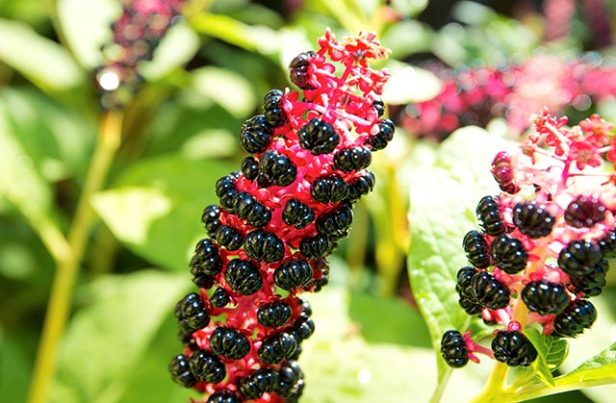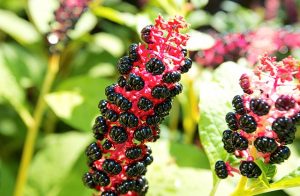
Phytolacca – sources, health benefits, nutrients, uses and constituents at NaturalPedia.com
Saturday, September 02, 2017 by Jhoanna Robinson
http://www.naturalpedia.com/phytolacca-sources-health-benefits-nutrients-uses-and-constituents-at-naturalpedia-com.html

Phytolacca is a genus of perennial plants that have long been used by Native Americans in traditional medicine. Some of the members of the genus are known as pokeweeds, poke sallet, pokeberry, pokebush, or pokeroot.
Phytolacca plants are usually found in found in northern and central North America, from the New England states to Minnesota, and south to Florida and Texas. They are also cultivated in Britain. They thrive in damp, fertile soils in clearings and meadows, roadsides, and woodland margins.
Some Native American tribes utilized phytolacca plants in witchcraft, believing that they have purgative properties that can rid the body of evil spirits via drastic diarrhea and vomiting.
List of known nutrients
- Beta-Carotene
- B43-PAP
- Carbohydrate
- Fatty Acids
- Lutein
- Vitamin B3 (Niacin)
Medicinal uses for phytolacca
Phytolacca has alterative, anti-HIV (human immunodeficiency syndrome), antiscorbutic (preventing scurvy), cathartic, parasiticide, anodyne (painkiller), anti-inflammatory, lymphagogue, anticancer, antirheumatic, antiviral, and expectorant properties.
New research has pointed to signs that childhood leukemia could possibly be treated with an immunotoxin that is found in pokeweeds, called B43-PAP. Its two parts include the B43 antibody (or anti-CD19) and the pokeweed antiviral protein immunotoxin. Their tandem works like this: once the B43 antibody finds a leukemia cell, it attaches itself to the cell, and the PAP brings its drug to the cell, thus effectively neutralizing it.
Phytolacca plants are a good treatment for mumps, which is a condition that is characterized by swelling of the salivary glands, a few days of fever, muscle aches, and tiredness.
Kids who are just starting to get their teeth in should be given a decoction of phytolacca plants to remove the discomfort of growing new teeth.
Phytolacca plants are good for the skin. They can treat scabies, which is characterized by a skin rash that looks like small red bumps and blisters that are spread throughout the affected body part, and aphthous ulcers, or oval sores that are found on the areas where the skin is not tightly linked to the bone, such as the inside of the mouth, the cheeks, or underneath the tongue. They also get rid of warts, acne, boils, eczema, and psoriasis.
Phytolacca plants can be used to fight infection. They can treat tetanus, which is acquired when bacteria get into a wound. They can even be used to address abscess, which is the painful collection of pus due to an infected area in the body.
Body systems supported by phytolacca
Phytolacca plants are good for the female reproductive system. They can be ingested to address breast diseases such as mastitis and breast tumors. They can even be used to stop leukorrhea, or the yellowish discharge of mucus from the vagina from sexually-transmitted diseases such as gonorrhea and syphilis, and ovary inflammations.
Phytolacca plants are good for the digestive system. They can serve as treatment for abdominal disorders and anal fissures, which are tears in the lining of the lower rectum, causing pain during bowel movements, edema, and stomatitis.
Phytolacca plants are good for the respiratory system. They can be used to treat laryngismus, or spasms in the larynx that cause difficulty in breathing; ozena, a chronic nasal disease that us characterized by odorous discharge; and diphtheria, a bacterial infection of the throat and nose.
Phytolacca plants are good for the cardiovascular system. They can relieve angina, which is chest pain that occurs when the heart muscle doesn’t get enough oxygen-rich blood.
Phytolacca plants are good for the ocular system. They can treat diplopia or double vision.
Phytolacca plants are good for the excretory system. They can be used to treat proteinuria, or the accumulation of too much protein in one’s urine, which can lead to kidney disease.
Phytolacca plants are good for the muscular system. They can treat neuralgia, which is characterized by a severe shooting facial pain due to damage of the nerves.
Ways to use phytolacca
Phytolacca berries are very poisonous when consumed raw, thereby causing diarrhea and vomiting. They should be prepared for consumption so that any untoward incidents won’t happen. Fresh phytolacca fruits, however, can be turned into a red dye that native tribe used to paint horses and articles of clothing.
Where to learn more
Summary
Phytolacca plants are good for the digestive, respiratory, cardiovascular, ocular, excretory, and muscular systems.
Phytolacca plants are good for the skin.
Phytolacca plants can be used to fight infection.
Sources include:
Tagged Under: Tags: phytolacca






